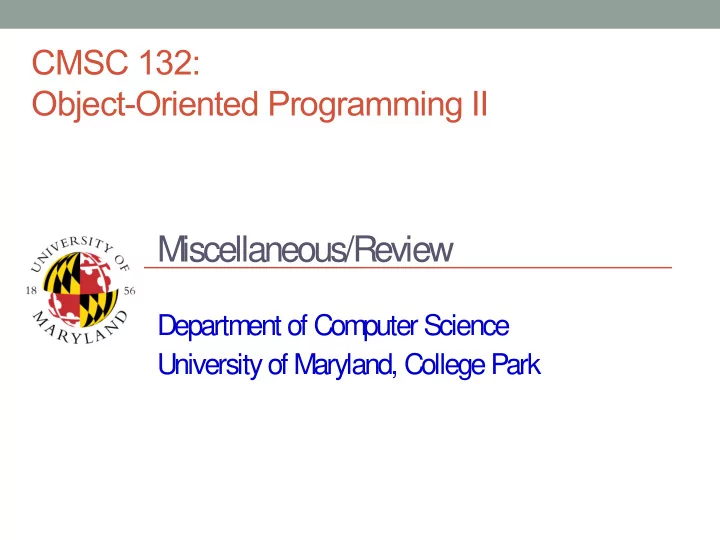

CMSC 132: Object-Oriented Programming II Miscellaneous/Review Department of Computer Science University of Maryland, College Park
IMPORTANT • Make sure you check your e-mails every day and the messages we post on the class announcements. It is your responsibility to check them so you are aware of important information/deadlines. • Final exam information is available on the class web page. • In the past, students have missed the final exam because they have the wrong date. Double-check now the current date and verify it with a classmate. • Please complete course evaluations • Save your projects for future reference. CVS repositories will be deleted after the semester is over. • Disconnect your projects from CVS (right-click on project, Team Disconnect) and discard your CVS location (go to the CVS Perspective, right-click on repository link, Discard location) after finishing the last project (otherwise you may get error messages regarding the nonexistent repository connection once we remove the CVS repositories) You should always try to use a different workspace location in the future – • FYI: For future advising sessions http://www.cs.umd.edu/~nelson/advising/ –
FYI: BitSet Class • Implements a set of bits where the bits of the set are indexed by nonnegative integers. • We could have used it for Sudoku • Methods BitSet() – New bit set – – BitSet(int nbits) – Bit set large enough to represent bits with indices from 0 through nbits – 1 – and(BitSet set) – Performs logical and between the current object and the set parameter (current object is updated with the result) or(BitSet set) – Performs logical or between the current object and the set – parameter (current object is updated with the result) cardinality() – Returns number of bits set to 1 – – flip(int bitIndex) – Sets the bit at the specified index get(int bitIndex) – Returns true if the bit at bitIndex is set; false otherwise – – length() – Index of the highest set bit + 1. It returns zero if the BitSet contains no bits set. – size() – Number of bits space used by the BitSet to represent bit values toString() – For every bit set, the decimal representation of that index is – included in the result.
Review • Note: this is NOT a complete list of the topics for the final. See the final exam information posted on the class web page for complete information. • Object-Oriented Principles – Abstraction How to design system based on provided descriptions – • Algorithmic Complexity Why we use it? – – What is the alternative? Examples – • Linear Data Structures – Traditional linked list (head) Project linked list (head and tail) – – Example: A method returning a list
Review • Note: this is NOT a complete list of the topics for the final. See the final exam information posted on the class web page for complete information. • Sets/Map – Different types Examples – • Trees Traditional vs. Polymorphic – – Examples • Software Development Kinds of testing – – Software Process Models Software Lifecycle – – Architectures • Multithreading – How to define threaded solutions How to avoid data races –
Review • Note: this is NOT a complete list of the topics for the final. See the final exam information posted on the class web page for complete information. • Graphs – BFS/DFS Dijkstra’s – • Sorting Performance of each algorithm – • Algorithm Strategies/Design Patterns • You don’t need to know UML But you can use it to provide answers if you want. – – Practice material may have UML exercises. Don’t write the UML, but write the solution to any design problem. • Java Abstract Classes vs. Interfaces – Comparable, Comparator – – Etc.
Questions about Final Exam Material • Any questions?
Recommend
More recommend